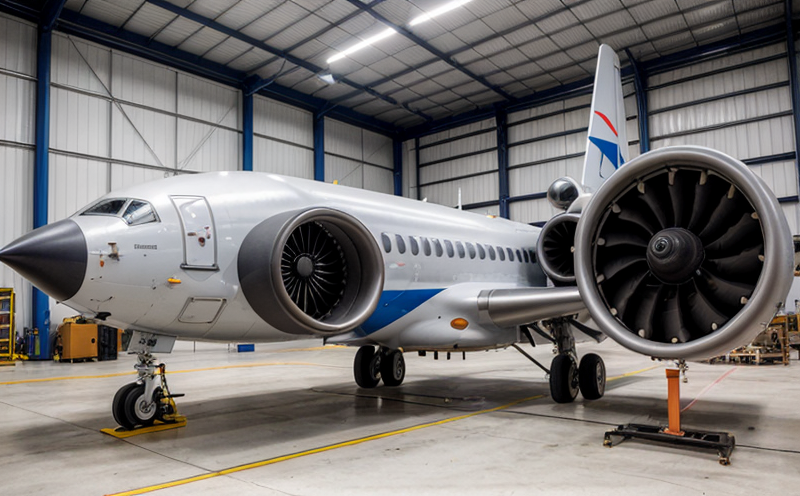Cabin Interior Noise Mapping for Passenger Aircraft
Ensuring a quiet and comfortable cabin environment is crucial in passenger aircraft. Cabin interior noise mapping involves detailed acoustic assessments that help identify areas of high noise levels within the cabin, which can be critical for both passenger comfort and crew well-being. This process plays an essential role in meeting regulatory standards and enhancing the overall air travel experience.
The importance of this service extends beyond mere compliance; it also contributes to passenger satisfaction and operational efficiency. Noise mapping provides insights into where noise sources are most prominent, enabling airlines to take proactive measures such as adjusting seating arrangements, improving insulation, or redesigning interior components. This not only enhances the comfort of passengers but can also reduce complaints and improve overall customer loyalty.
The testing process typically involves the use of advanced acoustic measurement equipment that captures sound levels at various points within the cabin. These measurements are then mapped out in a comprehensive report that highlights noise hotspots, their frequency ranges, and potential sources. This data is invaluable for both manufacturers and operators as they strive to meet stringent noise regulations set by organizations like the International Civil Aviation Organization (ICAO) and the Federal Aviation Administration (FAA).
Accurate cabin interior noise mapping requires meticulous attention to detail, ensuring that all components of the aircraft’s interior are considered. This includes not only seating areas but also overhead bins, partitions, and other enclosed spaces where sound can accumulate or reflect. The precision of these measurements is critical in identifying areas that may require intervention, whether for aesthetic or functional improvements.
The primary goal of cabin interior noise mapping is to ensure that the aircraft meets both internal quality standards and external regulatory requirements. This service is particularly important given the increasing focus on passenger comfort and safety, as well as environmental concerns. By addressing noise issues early in the design process, manufacturers can avoid costly rework and improve product performance from the outset.
The methodology for cabin interior noise mapping involves several key steps. Initially, a comprehensive acoustic survey of the aircraft is conducted using high-fidelity microphones placed at strategic locations within the cabin. These microphones capture sound levels across various frequencies, providing a detailed profile of the ambient noise environment. This data is then analyzed to identify areas where noise levels exceed acceptable thresholds.
Once identified, these areas are further investigated through targeted testing and analysis. This may involve placing additional sensors in specific locations or using advanced simulation software to model sound propagation within the cabin. The aim is to understand not only the current noise profile but also how it might change under different conditions, such as varying passenger loads or changes in seating arrangements.
Based on these findings, recommendations are made for improvements that can be implemented during either the design phase or after manufacturing. These may include modifications to existing components, incorporation of new materials, or changes to seating configurations. The ultimate objective is to reduce noise levels across the entire cabin while maintaining structural integrity and aesthetic appeal.
The benefits of effective cabin interior noise mapping extend beyond just meeting regulatory requirements. By proactively addressing noise issues early in the development process, airlines can improve passenger satisfaction, reduce operational costs associated with customer complaints or refunds, and enhance their reputation as leaders in providing a high-quality travel experience. Additionally, this service supports ongoing efforts to minimize environmental impact by optimizing sound insulation without compromising on design aesthetics.
In conclusion, cabin interior noise mapping is a vital component of ensuring that passenger aircraft meet the highest standards of comfort and compliance. Through precise measurement techniques combined with strategic recommendations for improvement, this service helps manufacturers and operators create more pleasant flying environments while adhering to industry best practices.
Applied Standards
| Standard | Description |
|---|---|
| AIC 61-003 | This standard specifies the procedures for determining the sound pressure levels in passenger cabins of civil aircraft. |
| FAR Part 25 Subpart E | Regulates noise standards for commercial transport category airplanes, including cabin interior noise mapping requirements. |
| EN 16803 | An EU standard that specifies the methods for measuring and assessing aircraft cabin interior noise levels. |
| IATA Resolution 745 | Promulgated by the International Air Transport Association, this resolution establishes guidelines for reducing noise in passenger cabins. |
Quality and Reliability Assurance
- Detailed documentation of all testing procedures and results.
- Compliance with internationally recognized standards such as AIC 61-003, FAR Part 25 Subpart E, EN 16803, IATA Resolution 745.
- Use of calibrated and certified acoustic measurement equipment to ensure accuracy and reliability.
- Ongoing training for technicians involved in performing noise mapping tests to maintain high standards.
Competitive Advantage and Market Impact
Implementing cabin interior noise mapping can significantly enhance a company's competitive edge by ensuring compliance with stringent industry standards while also improving passenger comfort. This service allows airlines and manufacturers to stay ahead of regulatory changes and customer expectations, thereby reducing the risk of non-compliance penalties or negative publicity.
In terms of market impact, addressing noise issues early in the design process can lead to improved product performance and better customer satisfaction. Airlines that invest in this service may see increased passenger loyalty and higher ratings for their services. Furthermore, compliance with international standards can open up new markets where these regulations are being enforced more strictly.
From a manufacturing perspective, effective cabin interior noise mapping ensures that products meet or exceed industry benchmarks, which is essential for maintaining a strong reputation in the competitive aerospace market. By demonstrating a commitment to quality and innovation, companies can differentiate themselves from competitors and attract business from discerning customers seeking superior offerings.





